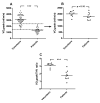Peak oxygen uptake in relation to total heart volume discriminates heart failure patients from healthy volunteers and athletes
- PMID: 21162743
- PMCID: PMC3022802
- DOI: 10.1186/1532-429X-12-74
Peak oxygen uptake in relation to total heart volume discriminates heart failure patients from healthy volunteers and athletes
Abstract
Background: An early sign of heart failure (HF) is a decreased cardiac reserve or inability to adequately increase cardiac output during exercise. Under normal circumstances maximal cardiac output is closely related to peak oxygen uptake (VO2peak) which has previously been shown to be closely related to total heart volume (THV). Thus, the aim of this study was to derive a VO2peak/THV ratio and to test the hypothesis that this ratio can be used to distinguish patients with HF from healthy volunteers and endurance athletes. Thirty-one patients with HF of different etiologies were retrospectively included and 131 control subjects (60 healthy volunteers and 71 athletes) were prospectively enrolled. Peak oxygen uptake was determined by maximal exercise test and THV was determined by cardiovascular magnetic resonance. The VO2peak/THV ratio was then derived and tested.
Results: Peak oxygen uptake was strongly correlated to THV (r2 = 0.74, p < 0.001) in the control subjects, but not for the patients (r2 = 0.0002, p = 0.95). The VO2peak/THV ratio differed significantly between control subjects and patients, even in patients with normal ejection fraction and after normalizing for hemoglobin levels (p < 0.001). In a multivariate analysis the VO2peak/THV ratio was the only independent predictor of presence of HF (p < 0.001).
Conclusions: The VO2peak/THV ratio can be used to distinguish patients with clinically diagnosed HF from healthy volunteers and athletes, even in patients with preserved systolic left ventricular function and after normalizing for hemoglobin levels.
Figures






Similar articles
-
Relation between cardiac dimensions and peak oxygen uptake.J Cardiovasc Magn Reson. 2010 Feb 1;12(1):8. doi: 10.1186/1532-429X-12-8. J Cardiovasc Magn Reson. 2010. PMID: 20122149 Free PMC article.
-
A moderate 500-m treadmill walk for estimating peak oxygen uptake in men with NYHA class I-II heart failure and reduced left ventricular ejection fraction.BMC Cardiovasc Disord. 2018 Apr 16;18(1):67. doi: 10.1186/s12872-018-0801-9. BMC Cardiovasc Disord. 2018. PMID: 29661150 Free PMC article.
-
Mechanisms of reduced peak oxygen consumption in subjects with uncomplicated type 2 diabetes.Cardiovasc Diabetol. 2021 Jun 22;20(1):124. doi: 10.1186/s12933-021-01314-6. Cardiovasc Diabetol. 2021. PMID: 34158062 Free PMC article.
-
Influence of Left Atrial Function on Exercise Capacity and Left Ventricular Function in Patients With Heart Failure and Preserved Ejection Fraction.Circ Cardiovasc Imaging. 2017 Apr;10(4):e005467. doi: 10.1161/CIRCIMAGING.116.005467. Circ Cardiovasc Imaging. 2017. PMID: 28360259
-
Assessment of left ventricular dimensions and functions in athletes and sedentary subjects at rest and during exercise using echocardiography, Doppler sonography and radionuclide ventriculography.Int J Sports Med. 1996 Nov;17 Suppl 3:S173-9. doi: 10.1055/s-2007-972920. Int J Sports Med. 1996. PMID: 9119539 Review.
Cited by
-
Diastolic Filling in Patients After Heart Transplantation Is Impaired Due to an Altered Geometrical Relationship Between the Left Atrium and Ventricle.J Am Heart Assoc. 2024 Jun 4;13(11):e033672. doi: 10.1161/JAHA.123.033672. Epub 2024 May 23. J Am Heart Assoc. 2024. PMID: 38780152 Free PMC article.
-
Cardiac contractile reserve parameters are related to prognosis in septic shock.Biomed Res Int. 2013;2013:930673. doi: 10.1155/2013/930673. Epub 2013 Jul 17. Biomed Res Int. 2013. PMID: 23957012 Free PMC article.
-
Prognostic value of peak work rate indexed by left ventricular diameter.Sci Rep. 2023 May 31;13(1):8806. doi: 10.1038/s41598-023-35976-x. Sci Rep. 2023. PMID: 37258692 Free PMC article.
-
Effects on Cardiac Dimensions and Peak Oxygen Uptake After Long-Term Deconditioning in Elite Athletes.Scand J Med Sci Sports. 2025 May;35(5):e70071. doi: 10.1111/sms.70071. Scand J Med Sci Sports. 2025. PMID: 40387290 Free PMC article.
-
Review of Journal of Cardiovascular Magnetic Resonance 2011.J Cardiovasc Magn Reson. 2012 Nov 18;14(1):78. doi: 10.1186/1532-429X-14-78. J Cardiovasc Magn Reson. 2012. PMID: 23158097 Free PMC article. Review.
References
-
- Dickstein K, Cohen-Solal A, Filippatos G, McMurray JJ, Ponikowski P, Poole-Wilson PA, Stromberg A, van Veldhuisen DJ, Atar D, Hoes AW, Keren A, Mebazaa A, Nieminen M, Priori SG, Swedberg K, Vahanian A, Camm J, De Caterina R, Dean V, Dickstein K, Filippatos G, Funck-Brentano C, Hellemans I, Kristensen SD, McGregor K, Sechtem U, Silber S, Tendera M, Widimsky P, Zamorano JL. ESC Guidelines for the diagnosis and treatment of acute and chronic heart failure 2008: the Task Force for the Diagnosis and Treatment of Acute and Chronic Heart Failure 2008 of the European Society of Cardiology. Developed in collaboration with the Heart Failure Association of the ESC (HFA) and endorsed by the European Society of Intensive Care Medicine (ESICM) Eur Heart J. 2008;29(19):2388–442. doi: 10.1093/eurheartj/ehn309. - DOI - PubMed
-
- Wheeldon NM, MacDonald TM, Flucker CJ, McKendrick AD, McDevitt DG, Struthers AD. Echocardiography in chronic heart failure in the community. Q J Med. 1993;86(1):17–23. - PubMed
-
- Hunt SA. ACC/AHA 2005 guideline update for the diagnosis and management of chronic heart failure in the adult: a report of the American College of Cardiology/American Heart Association Task Force on Practice Guidelines (Writing Committee to Update the 2001 Guidelines for the Evaluation and Management of Heart Failure) J Am Coll Cardiol. 2005;46(6):e1–82. doi: 10.1016/j.jacc.2005.08.022. - DOI - PubMed
-
- Ekblom B, Hermansen L. Cardiac output in athletes. J Appl Physiol. 1968;25(5):619–25. - PubMed
MeSH terms
Substances
LinkOut - more resources
Full Text Sources
Medical
Research Materials
Miscellaneous

